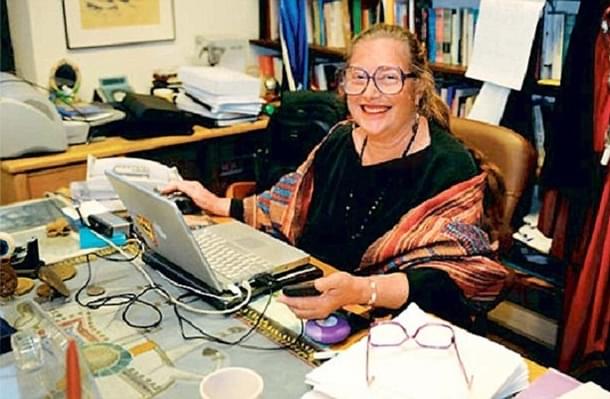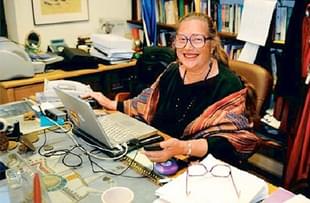Culture
Wendy Doniger Is Wrong, Again
Naveen Chandra
May 05, 2016, 03:46 PM | Updated 03:46 PM IST
Save & read from anywhere!
Bookmark stories for easy access on any device or the Swarajya app.


- Wendy Doniger makes a series of errors in her article - ‘The Repression of Religious Studies’.
- Her allegations show us how wrong several American Orientalists are.
The article ‘The Repression of Religious Studies’ by Wendy Doniger touches on many topics of which I chose to address a few.
Intellectual Territorial Integrity Violations
Soon after Rajiv Malhotra’s seminal book (The Battle For Sanskrit) came out, scholars from various fields signed a petition to remove Sheldon Pollock from the leadership of Murty Classical Library of India, among whom was Makarand Paranjpe, a JNU professor of English. Makarand Paranjpe also wrote an eloquent article to explain why he signed the petition. Either Wendy Doniger didn’t read it or didn’t understand it or has chosen to ignore it or all the above. She accuses him of violating the intellectual territory of indologists despite not being one by commenting on these issues. Didn’t she too do a similar thing in the past?
Sheldon Pollock himself invaded the intellectual territory of others on 27 August 2015, when he signed a petition to bar Narendra Modi, India’s Prime Minister from going to Silicon Valley. The petition was characterized as “far Left” by the Silicon Valley Engineers. They prepared a counter petition with a very strong representation from faculty in engineering disciplines, who, arguably, are best prepared to comment on Digital India, welcoming Modi.
Qualifications of Sheldon Pollock Questioned
- Pollock’s previous experience with Clay Library has to be looked into. Translations by Doniger (“Harsh Ratnavali”) and Pollock (“Raghu Vamsa “and “Rasamanjari”) were found to have many pitfalls . His translation of a single verse from Chandodogyopanishad was found to contain as many as 12 errors.
- It is clear that Pollock is a man of contradictions. For example in a paper published in 1985 he at one place says sastras are prescriptive followed by the statement later that there were professions which did not follow any sastras. Elsewhere, he says at one place Sanskrit helped the languages of Southeast Asia followed by statement that Sanskrit killed those languages.
- He works with a theory, cites data supporting that theory and ignores data that doesn’t agree with it. His theory is that the sastras were repressive of the society. He says these texts are dogmatic, regressive used for political and social oppression, without providing any evidence for the same. He quotes Kautilya who showed disdain for sastras but does not follow up on this stream of thought and ignores it when concluding in support of his theory.
- For a man who spent 40 years writing about Hinduism, his knowledge of his subject matter has many gaps. He missed major paradigm shifts in Hindu philosophy: Vedas, Upanishads, Darshanas, Advaita, Visishtadvaita and Dvaita each represented a change suggesting an evolution of thought. He does not mention this important feature of Hindu philosophy.
- He says that the worship of Ram is a ‘cult’ popularized around the 12th century to rally the masses against the Turkish invaders by projecting them as the demonic ‘other’. Is he suggesting that Ravana the villain of Ramayana was a Muslim? Even though Ravana was a Brahmin, he did not escape punishment for his misdeeds. Historical references to Ramayana date back, as Nandita Krishna says, to Lumbini pillar erected by Ashoka in 249 BCE. Famous Sanskrit books such as Uttararamacharita by Bhavabhuti in eighth century and Raghuvamsa by Kalidasa in the fifth century, based on Ramayana were written well before 12th century. In Sangam literature, in the book Puranaanooru, in verse 378, there is a mention of jewels of Raman’s wife Sithai. This could have been anytime between the fourth century BCE and the fifth Century CE.
- His opinion that Sanskrit is a ‘dead’ language whose revival was done by barbarous invaders coupled with his assertion that “The German Holocaust was inspired by the Nazis reading of Sanskrit texts” is not evidence based.
- His statement that Rama didn’t have free will and was a fatalist to accept decisions made by his father assumes that Rama was incapable of making any decisions independently. The events in Ramayana show otherwise: Rama’s dealings with Sugreeva, Hanuman and Vibheeshana show him as a very sagacious person and his conduct in war show him as a capable leader and fighter.
There are many other issues on which Pollock either does not understand Hindu documents or is willfully misrepresenting them. These are enough to show that he is not capable of running a classical library of Indian languages translated into English.
What does Rajiv Malhotra say?
Rajiv Malhotra says of Pollock, “I found Pollock’s modus operandi to be work back from a conclusion, offering selective references to support it, and oftentimes simply base it on an assumption with no evidence to back it.”
We saw above ample evidence for this. Malhotra asks questions such as: did Sanskrit prevent anyone from learning? Are Hindus fatalists? Are sastras repressive? Did Vedas prevent the growth of knowledge? Are the rishis similar to the christian priests of medieval Europe? What is the true meaning of four ashrams? What is the true meaning of four purusharthas? Does Karma prohibit meaningful engagements of individuals in making families and communities prosperous? Is Hindu society chaotic? and asks Hindus to learn about their history and practices much to the chagrin of South Asian Studies scholars who make assertions denigrating dharma. Malhotra asks Hindus to do poorva paksha and uttara paksha to get to the truth much to the discomfort of American Orientalists. Malhotra brings to the attention of Hindus, the works of Reinhold Guenendahl that refute Pollock but does not get the public exposure they deserve. Naturally a truth seeker like Malhotra gets the ire of a prevaricating Wendy Doniger.
Brahmins Blamed Again
Wendy Doniger says the wealthy Brahmins in the US support Malhotra in his battle against her and Pollock. Is there a grain of truth in this citadel of wild claims? Why did’t she do some homework before making so baseless an allegation? American Orientalists have signed close to fifteen petitions against Hinduism, India, Modi and similar causes sometimes in the numbers exceeding 500, including Wendy Doniger. Many of these are also persons of Indian origin. Did she check how many of them were Brahmins? Isn’t it a bit hypocritical to cry that Brahmins support Malhotra at the same time drawing huge support from them to her cause?
Book banning : Satanic Verses ?
The author of The Hindus did not in her own words suffer from the protests against it. The book was not banned. It was sold under the counter stealthily. She likes it that she has upped the Hindu objectors. She made money albeit immorally using intellectual dishonesty, whereas Satanic Verses was banned. Does the author claim her book is comparable to Satanic Verses in literary values such as style, creativity and language? Why did her book, an instrument in the hands of evangelists, do better financially and politically but miserably fail intellectually? Which book will survive in the long run? Compare the magnanimity of Hindu objectors that allowed the sale of The Hindus to continue, to the doggedly mindless and vicious campaign that banned Satanic Verses. By the way on what side is she and her friends on the banning of the Satanic Verses?
Most American Orientalists are outdated in their knowledge, prevaricating, hypocritical, unscientific and irrational promoters of hatred against Brahmins as well as ignorant of Hinduism and lack academic integrity. I as a Hindu would not want them to write about Hinduism.





